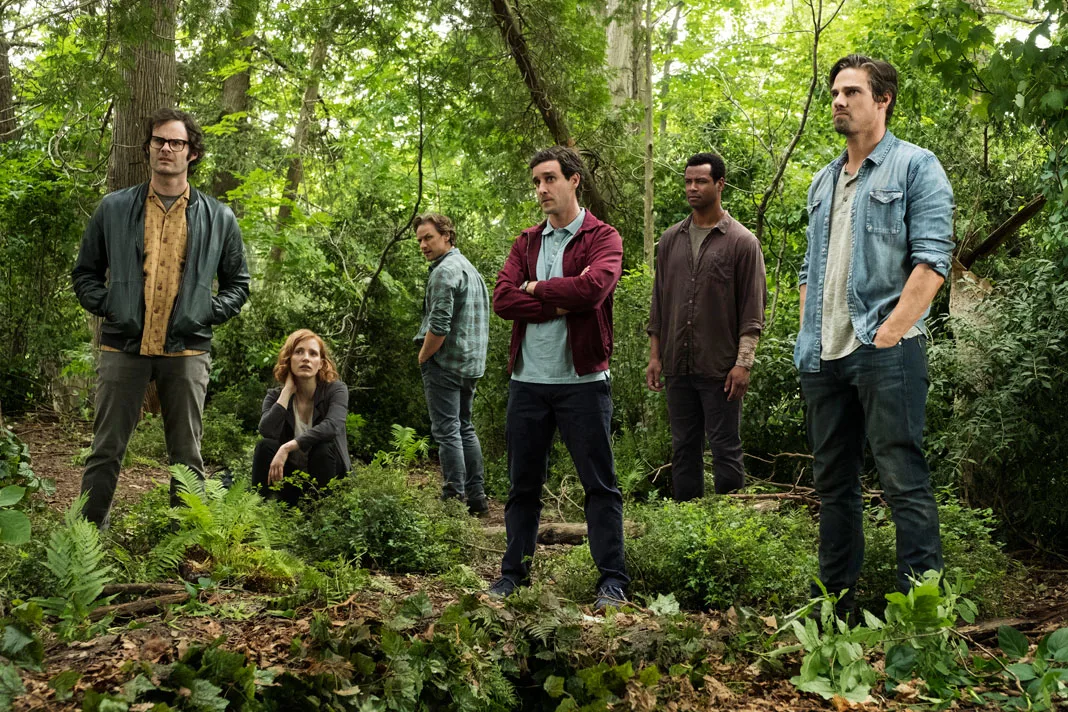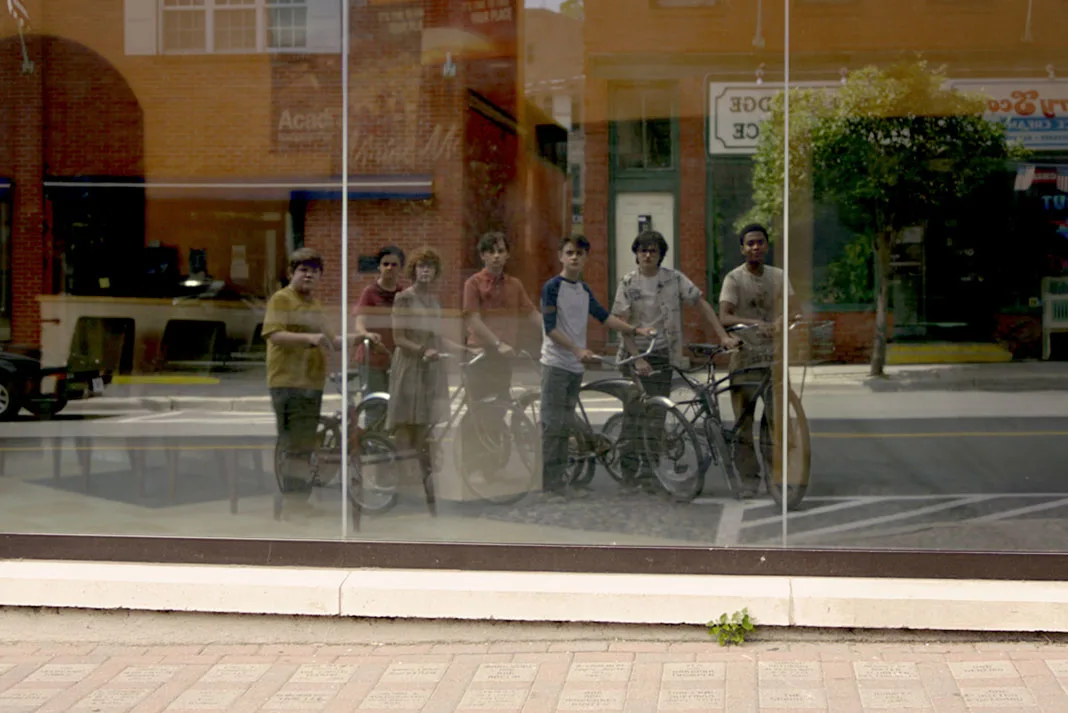It Chapter Two is a glorious mess. When the decision was made to split Stephen King’s It into two films, it seemed a sensible choice. The novel is over 1,100 pages long, and even the space of two lengthy films couldn’t possibly cover everything. King’s novel not only dives into the characters of the Loser’s Club but also into the mythology of Pennywise the Clown, the history of Derry, and the nature of fear as it affects people throughout their lives.
Something’s going to get cut, and even while those of us who are fans of the novel thought a film concentrating solely on the kids was a sure thing, it certainly didn’t feel that way to the filmmakers. Of course, It (2017) was a huge success and allowed the filmmakers to proceed with the sequel.
However, splitting the story this way intrinsically has its own challenges. Fans of the book acknowledge that the sections with the children are more effective than the adult sections, and the filmmakers know that. It’s the easiest to tell and resonates the strongest. It Chapter One is one of the most financially lucrative horror films ever made.
Any follow-up has huge clown shoes to fill. Yes, the audience is eager to see this story continue, but anyone who has read the book knows that the adult section gets… strange. Some of it is practically unfilmable. A lot of it is more literary than cinematic, and the filmmakers had to know going in that they had a steep hill to climb.

But additional problems arise that perhaps the filmmakers didn’t anticipate (or just ignored): much of It Chapter Two has Beverly Marsh (Jessica Chastain), Bill Denborough (James McAvoy), Richie Tozier (Bill Hader), Eddie Kaspbrak (James Ransone) and Ben Hanscom (Jay Ryan) struggling to remember that fateful summer of 1989. Only Mike Hanlon (Isaiah Mustafa) remembers everything because he never left Derry.
When Mike calls them all back to finish what they started with Pennywise (Bill Skarsgård), what is still fresh in the audience’s mind is deliberately vague in theirs. This has the effect that the audience is, for most of It Chapter Two’s running time, ahead of the characters. We know exactly what is happening even when most of the other characters don’t.
This takes away a lot of the suspense, and for a horror film, that can be a death blow. The original novel intercut the children’s sections with the adult sections, so we experience what’s happening along with the characters. But much of It Chapter Two consists of us waiting impatiently for our heroes to catch up with us.
It Chapter One was already pretty long by horror film standards, but to be fair, that film had a lot of ground to cover (and covered it well). It Chapter Two is longer — almost three hours — but while the first film flowed well, Chapter Two is sporadic and erratic. Sequences that should have been truncated are too lengthy, while other sequences, especially the film’s first 30 minutes, leap forward when the film needs to take its time. We barely register with the Loser’s Club as adults before we are whisked back to Derry and into the thick of things.
The film only gives us snippets of their lives when we need a deeper dive, but while this may be easier to accomplish in a novel, the film has to keep moving forward and can’t take the time. Asking what scenes to shorten or remove in It Chapter Two can be a bit like asking what notes to remove from a symphony — again, there’s a lot of ground to cover — but you feel the length of the movie, especially during those scenes where the characters are going through familiar turf.
And even at the length of the film, there is a lot from the book that was left out. The removal of some plot threads makes sense, but some of those threads added more context to the characters and to the story.
Finally, the explanation of what Pennywise is works on the page but doesn’t necessarily translate well to the screen, especially in the film’s final act, which wants to be all things to all people – to effectively give a cinematically-satisfying ending to the story while staying somewhat true to the novel as best as the filmmakers can. The climax of It in the novel could best be described as Lovecraftian and not particularly visual, and outside of the context of the novel, it can be difficult to interpret (I spent about half an hour after the movie trying to explain it to non-readers and gave it up – spoken out loud a lot of it sounds silly and pretentious even as it works in the book).
Is It a supernatural being, an alien, or something else? While the book lets us play with that in our minds, the film requires a more definitive explanation, which it cannot satisfactorily provide. The result is a very muddled climax, which, while visually interesting, may leave moviegoers scratching their heads. Plus, we get less of Bill Skarsgård this time around, and since he was such a commanding and scary presence in the first film, that absence is felt strongly.
Films like It Chapter Two are interesting from a critical perspective, however, because what the film gets right, it gets really right. I can’t dismiss this movie, even through all the problems, because when this movie is working, it pops and thrills in ways that the best horror films do. Most of this comes from the performances – some are stronger than others, but everyone is doing good work with their material.
While I can see why Jessica Chastain was eager to play the role, there is a bit of a disconnect between what Chastain does and what Sophia Lillis did in the first film. She delivers where it counts, though. The same goes for James McAvoy, who gets a few nice moments and brings emotion to many of his scenes as we see how Bill has struggled with the summer of 1989 all his life.
Jay Ryan’s Ben, sadly, doesn’t have a lot of agency and isn’t given much to do except pine over Chastain’s Beverly. Isaiah Mustafa’s Mike is the center that brings them together, but he mostly serves as exposition to the more zany twists of the story, and while he does good work with it, I would have appreciated a more thorough look into Mike’s life in Derry.
The standout performances, though, are from Bill Hader and James Ransone. They carry the movie on their backs, and every scene with those two is worth the price of admission alone. Hader’s Richie has grown up to be a successful stand-up comic, but he still has a few secrets and issues that he hasn’t dealt with, and returning to Derry brings them all flooding back. Hader is terrific, fulfilling the promise of Finn Wolfhard’s portrayal in the first film. He’s funny, earnest, and more than any other performance, commits to the twists and turns of the story and makes us believe them.
As portrayed by Ransone, Eddie is still very much the hypochondriac he was as a boy, but more than the other characters, we can feel the absence of meaningful relationships in Eddie’s life, and when he returns to Derry, we can feel the love that he carries for his friends, even through the terrifying moments. Both bring a lot of the humor to the film. It Chapter Two is a funnier film than the first, sometimes to the film’s detriment – some of the laughs take us out of the movie, but those moments are few.
It Chapter Two works best during those moments of juxtaposition between the adults’ experiences and the kids’ experiences. The film’s middle hour is when the movie truly soars – director Andy Muschietti understands that the best moments of the first film are when we stick closely to the relationships between the members of the Loser’s Club, and those are the best moments of the sequel as well.
The moments we do get with Pennywise are suitably creepy, and It Chapter Two doesn’t spare the terror, especially when the kids of Derry are involved. There’s enough suitable nightmare fuel for little ones that parents should probably steer clear with their kids, maybe more so than the first one. Along with the first film, this is an effective Benjamin Wallfisch score, accentuating the emotional beats but also knowing when to disturb and frighten.
Andy Muschietti definitely knows how to orchestrate a jump scare, but sometimes it’s a bit too telegraphed, especially when the score rises and pauses just before a scary moment. And, again, since we are ahead of the characters, a lot of the scary moments just don’t operate on the level that they should. There are a few CGI moments that disconnect us from the film, especially during the climax, where the filmmakers truly bite off more than they can chew.
So, long review short, is It Chapter Two worth seeing? Guardedly, yes. It’s not as satisfying as the first by any stretch of the imagination. And due to the splitting of the story, perhaps a later edit with both films spliced together as they are in the book may make some of the complaints about Chapter Two go away (granted, it would probably run about six hours and would be more conducive to home viewing than in a theater). It’s bloated.
Some of the changes to the novel’s plot don’t connect as well, and other aspects they keep from the novel don’t translate cinematically. But when the film hits its stride, when the filmmakers don’t force the story to fit into strict parameters and just let the story flow with these characters that we love, It Chapter Two can be just as effective and emotional as the first film. Fans of the novel shouldn’t miss this because much of what we love about the book makes its way to the screen, even if it can’t hit every high point completely. It Chapter Two is clunky, too long, and not as scary as it could have been, but when it hits, it really hits.
IT CHAPTER TWO REVIEW RATING: 6/10
It Chapter Two opens in theaters on September 6. The film has been rated R for “disturbing violent content and bloody images throughout, pervasive language, and somecrude sexual material.” Click here for all our It Chapter Two coverage.

Alan Cerny has been writing about film for more than 20 years for such sites as Ain’t It Cool News, CHUD, Birth Movies Death, and ComingSoon. He has been a member of the Houston Film Critics Society since 2011. STAR WARS biased. Steven Spielberg once called Alan a “very good writer,” and Alan has the signed letter to prove it, so it must be true.

